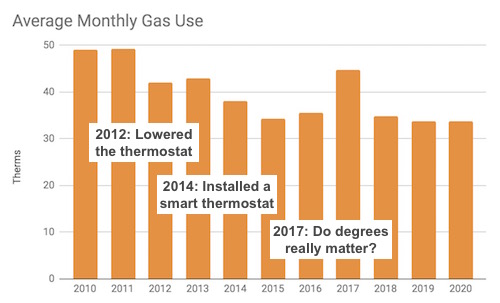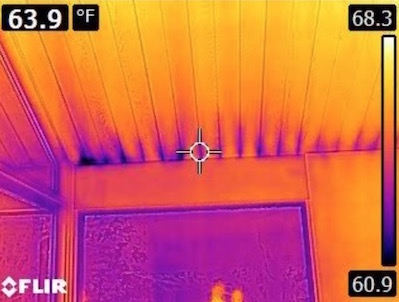I’ve already talked about our efforts to use less electricity, which have been both successful and fun. Water has been a tougher nut to crack, but that will wait for another week. Today’s post is about gas, and I’d say we have been moderately successful in reducing our gas use. I want to relate how it’s gone, hear from you what you’ve tried, and generally encourage all of us to consider some of these ideas. As we experience and learn more about the impacts of climate change, the less comfortable it feels to be burning lots of gas.

Burning gas in a home furnace
Before I begin, though, you may be wondering how much is “lots of gas”. As one frame of reference, half the single family homes in Palo Alto use at most 400 therms a year, or 33 therms a month on average. That is probably around 70 in winter months and 10 in summer. For multi-family households, the number is smaller, with half of households using at most 290 therms a year, or 24 therms a month on average. Average use metrics are higher because of the spread at the high end.

Data for Palo Alto homes from the most recent fiscal year, from the City of Palo Alto Utilities
Since almost all gas use goes towards heating, larger homes and/or leakier homes will use more gas. How does your use compare?
I began home ownership with a whopper of a gas bill. In October of 2009, while wrapping up a remodel before moving in, I got stuck with a $450 gas bill (236 therms) because my contractor opted to turn up the heat to dry the sheetrock mud even though the house had no windows. It worked, but talk about warming the planet…
Once we moved in, with windows in place, our gas bills stabilized and have gradually decreased.

Average monthly gas use over the years for our 2100 sf house
In 2012 I lowered our thermostats one or two degrees, which was not noticeable but reduced our gas use by about 14% to an average of 42.5 therms/month. In mid-2014 I installed a smart thermostat and fine-tuned two others, which reduced our gas use by another 19%. I was more careful about scheduling when we needed heat and reducing heat in different areas of the house at different times of day.
In 2017 I wanted to see if the fine-tuning really made a difference, so I programmed a more liberal schedule where more areas of the house stayed warmer for longer. Those adjustments made a big impact on gas use, as you can see -- a 30% increase -- so I reverted to a more careful schedule. At this point we are down to about 34 therms/month, or right around the median for single-family homes in Palo Alto. Is there more we can be doing? Sure. But first I want to talk about what we’re doing right.
1. Insulation. There is no substitute for good insulation. Our house has a foam roof, insulation in the exterior walls, and good windows. We have a lot of windows, which is not ideal, but at least they are modern windows, professionally installed. Before I moved here, I rented a house in Mountain View for six years that felt more like a tent than a house. It had no insulation anywhere and single-pane windows, so it was freezing in the winter and boiling in the summer. It was a small house, about 1200 sf, with just two small wall heaters, but the gas bills were routinely around $150 a month in the winter, twice what ours are today. The rent was a good deal, though, so I didn’t say anything. One day the landlord informed me that he was going to replace the roof, since he’d come to take a look at the house and noticed the roof was falling down(!). He put up a foam roof and it made a world of difference. Summers stayed cool inside, winters stayed warm and used much less heat. Winter gas bills dropped to around $70. I vowed if I ever had my own house that it would be well insulated.
2. Smart thermostat. You can do a lot with a regular thermostat, but so-called “smart” thermostats offer more flexibility to keep you comfortable while also saving energy. For example, they can adjust the heat automatically based on whether or not you are home. But much more is possible. Just a few days ago, my Nest thermostat began offering an optional “Seasonal Savings” program in which it tweaks energy use in what it hopes are invisible ways and then measures the effect. As Nest describes it: “When Seasonal Savings is adjusting temperatures, the changes it makes are subtle, just a fraction of a degree each day. Over the course of the entire tune-up period, the changes typically add up to about 1F or 1C. The biggest temperature adjustments usually happen while you’re asleep or away, so you may never even notice the changes made by Seasonal Savings.” I love this idea, and it works! (1)

3. Lower the temperature. This is a no brainer, so don’t be afraid to try a lower temperature in the winter. If you don’t like it, you can always bump it up some. The City suggests 68. We found we are comfortable with lower temperatures as long as we wear sweaters and warm socks in the house. Then we fight over the best blankets in the evening when watching TV. (Our dog, unfortunately, likes what I think is the best one.) Good comforters also make it easy to lower night-time temperatures.

Do these changes make a big difference? It’s interesting to look at our experimental “don’t be so careful” 2017 in comparison with 2018.

You can see that our gas use was about 50% higher in the winter months even though the adjustment I made wasn’t huge, just a few hours more of heat in different parts of the house, maybe a degree or two warmer. Our annual gas bill went from $730 in 2017 down to $560 in 2018 when I tightened up the schedule. It pays to spend some quality time with your thermostat.
What next?
Our gas use is still higher than I’d like. There are some things we can do. One is to seal where the wood ceiling planks meet the walls. There is a gap there throughout the house, common in Eichlers, that leaks some heat. This is probably not expensive to do, but I’m not super handy. What kind of caulk? How to apply it properly? So I’ve been sitting on this one.

A gap between the ceiling planks and the wall board lets out warm air.
Another way to reduce gas use would be to use window coverings at night. Someone wrote to me that “I live in the cooler redwoods of La Honda with only a wood burning stove and have found that it is very helpful to close the blinds to keep the heat in!” I think it’s a great idea, but for us it would be expensive (we have lots of big windows) and tedious (closing and reopening them each day), plus I’m not wild about the idea aesthetically. I’m going to pass on this.

Windows are beautiful, but not the best for heat retention.

This photo, courtesy of Palo Alto’s Home Efficiency Genie, shows in purple where the heat is leaving at the ceiling and windows.
The simplest thing we could do that would make a big difference is probably to replace our gas tank hot water heater with a heat pump. I was surprised to see how much gas we use for hot water. Here’s what our gas use looked like last year.

Our only gas use is space heating, water heating, and the stove, and I estimate that our water heater uses about 12 therms a month on average. (When we are out of town the idle water heater uses about one-third of a therm of gas a day, or ten therms a month.) Since we use 34 therms/month total, the water heater is a little more than one-third of our use. While there are some small things we could try to reduce our hot water gas use, like further lowering the temperature or adjusting the recirc timer, our best bet is the heat pump water heater. They work well, but the economics are an interesting story. I’ll be writing more about that option in my next blog post. In the meantime, I’d love to hear what you’ve tried to reduce your gas use, or if you are thinking of trying something this winter. There’s no time like the present!
Notes and References
0. Acterra is celebrating “Veganuary” this month, offering help to anyone who is interested in eating a more plant-based diet. Interest in this is growing rapidly and can make a big difference for the planet. “Even a small shift towards a plant-based diet is impactful when done over time and in concert with others in the community. Omnivores can start as small as Meatless Mondays or maybe try three or four days a week of meat-free eating. January is a perfect month for new beginnings.” says program director Nicole Angiel. Learn more about how Acterra can help you make the changes you are thinking about.
1. Nest ran their "Seasonal Savings" program during the winter of 2017 in southern California with SoCalGas. “Initial results from the energy efficiency pilot program indicate that Nest smart thermostat owners who participated in the program saved an average of 8 percent more on their home heating use this past winter than the average Nest customer without that program. The 8 percent savings, which collectively adds up to about as much natural gas as it would take to dry 2 million loads of laundry, comes on top of the 10-12 percent average savings on home heating and cooling already attributable to Nest thermostats in the United States.” Smart thermostats FTW!
2. One of the reasons it’s harder to analyze and adjust gas use than electricity use is that the measurements are coarse and very variable (e.g., weather dependent). Here are measurements for the last twelve days at our house.

Home gas measurements are coarse and variable.
Current Climate Data (November/December 2020)
Global impacts, US impacts, CO2 metric, Climate dashboard (updated annually)
The year 2020 tied for the warmest year on record. This upwards trend will continue until we zero out our emissions.

This graph shows the annual temperature differential (in C) from 1981-2010 over the years. We are already one degree F over that recent period, and 2.25F over the preindustrial baseline. 2020 ties 2016 for the warmest year on record. (Source: Copernicus Climate Change Service/ECMWF)
Comment Guidelines
I hope that your contributions will be an important part of this blog. To keep the discussion productive, please adhere to these guidelines or your comment may be moderated:
- Avoid disrespectful, disparaging, snide, angry, or ad hominem comments.
- Stay fact-based and refer to reputable sources.
- Stay on topic.
- In general, maintain this as a welcoming space for all readers.



